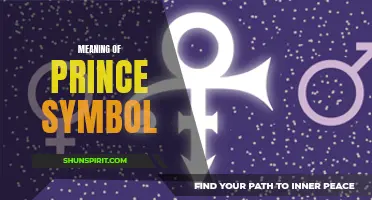
Blue eyes have always captivated the human imagination. They are often associated with beauty, mystery, and a sense of depth. But did you know that blue eyes also hold symbolic meanings in different cultures around the world? From representing wisdom and clarity to symbolizing trust and loyalty, blue eyes have been revered and interpreted in diverse ways throughout history. So, whether you have mesmerizing blue eyes yourself or simply appreciate their symbolic significance, delve into the intriguing world of blue eye symbolism and discover the hidden meanings behind this enchanting hue.
What You'll Learn
- What is the cultural or historical significance of the blue eye symbol?
- How does the meaning of the blue eye symbol vary across different cultures or regions?
- Are there any specific religious or spiritual beliefs associated with the blue eye symbol?
- What are some common interpretations of the blue eye symbol in modern society?
- How has the meaning of the blue eye symbol evolved over time?

What is the cultural or historical significance of the blue eye symbol?
The blue eye symbol, also known as the "Evil Eye," is a cultural and historical symbol with significant meaning in various societies around the world. This symbol holds great importance in different cultures due to its perceived ability to provide protection against evil forces and malicious spirits.
The origins of the blue eye symbol can be traced back to ancient Mesopotamia, where it was commonly used to ward off evil spirits and protect against the "evil eye" curse. The belief in the evil eye, which is believed to cause harm or misfortune, is prevalent in many cultures and has been passed down through generations.
In Turkish, the blue eye symbol is called "Nazar Boncugu," which translates to "evil eye bead." This traditional symbol is often made of glass or ceramic and is often worn as jewelry or displayed in homes and businesses to ward off evil. The vibrant blue color is believed to be particularly effective in repelling negative energy.
In Greek culture, the symbol is known as "Matiasma" or "Kako Matia," meaning "bad eye" in English. It is believed that certain individuals possess an evil eye that can harm others unintentionally or intentionally. To protect against this, various types of blue eye amulets are used, including pendants, bracelets, and even small, round objects called "komboloi" that can be carried in pockets.
Similarly, in Middle Eastern and North African cultures, the blue eye symbol holds great significance. Known as "ayn al-hasūd" or "ayn al-ḥassūd" in Arabic, it is believed to protect against envy and malevolence. The symbol is often displayed in homes, cars, and even on clothes to safeguard individuals and their possessions.
The blue eye symbol has also gained popularity in recent years as a global fashion trend. Many individuals, regardless of their cultural background, wear blue eye jewelry or use it as a decorative element. This trend has helped spread awareness about the symbol's cultural and historical significance.
In addition to its protective qualities, the blue eye symbol is considered a symbol of good luck and prosperity in various cultures. It is believed that wearing or displaying the symbol can attract positive energy, repel negativity, and bring good fortune to the wearer.
Overall, the blue eye symbol holds immense cultural and historical significance across different societies. It is a powerful symbol that is believed to protect individuals, ward off evil, and bring good luck. Whether worn as jewelry or displayed in homes, the blue eye symbol continues to be a cherished and respected emblem in many cultures around the world.
Exploring the Depth of Meaning Behind the St. Michael Symbol
You may want to see also

How does the meaning of the blue eye symbol vary across different cultures or regions?
The blue eye symbol holds different meanings across various cultures and regions. While it is primarily associated with protection against the evil eye, its significance can differ depending on the context and belief systems of different groups.
In Mediterranean and Middle Eastern cultures, the blue eye symbol, also known as the Nazar, is believed to protect against curses and evil forces. It is commonly seen in the form of amulets, jewelry, or charms, and is thought to ward off negative energy and misfortune. People often wear the blue eye as a talisman to bring good luck and keep the evil eye away.
In some Eastern European cultures, such as Greece and Turkey, the blue eye symbol is also associated with fertility and motherhood. It is believed to provide protection for pregnant women and newborns, ensuring their well-being and warding off any harmful energy that may be directed towards them.
In other parts of the world, such as South America and Africa, the blue eye symbol may have different connotations. In Brazil, for example, it is known as "Olho Turco" and is associated with good luck and positive energy. Similarly, in parts of Africa, the blue eye symbol is seen as a protective amulet and is believed to bring blessings and ward off adversity.
Interestingly, while the blue eye symbol is commonly associated with protection and good luck, its interpretation may vary even within the same culture. For instance, in some parts of Turkey, the blue eye symbol is believed to not only protect against the evil eye but also cause jealousy or envy. It is thought that wearing the symbol may attract attention and admiration from others, which can potentially lead to envy or negative feelings.
In addition to its cultural significance, the blue eye symbol has gained popularity in the realm of fashion and aesthetics. It is often seen in various forms of artwork, home decor, and fashion accessories, appealing to individuals who may not have a specific belief or cultural background associated with the symbol. In these contexts, the blue eye may be appreciated for its aesthetic appeal or as a trendy and fashionable item.
In conclusion, the meaning of the blue eye symbol can vary across different cultures and regions. While its primary association is with protection against the evil eye, it can also be linked to fertility, motherhood, good luck, and positive energy. Furthermore, its interpretation may even differ within the same culture. Whether worn as a cultural symbol, a fashionable accessory, or both, the blue eye continues to hold significance and intrigue across various societies.
Understanding Mitsubishi Mirage Dashboard Symbols and Their Meanings
You may want to see also

Are there any specific religious or spiritual beliefs associated with the blue eye symbol?
The blue eye symbol, also known as the evil eye, is believed to protect against negative energies in many cultures and religions around the world. While its exact origins are uncertain, it is widely recognized and respected across various belief systems.
In some religious traditions, such as Islam and Judaism, the blue eye symbol is associated with the concept of the evil eye. This is the belief that some individuals possess a malevolent gaze that can bring harm or misfortune to others. As a result, the blue eye symbol is often used to ward off this negative energy and protect against its effects.
In Islamic culture, the blue eye symbol, known as the Nazar, is particularly popular. It is believed to have the power to repel the evil eye and safeguard against its harmful influence. The symbol is often worn as jewelry, such as pendants or bracelets, or displayed in homes and businesses as a form of protection. The color blue is thought to be especially effective in deflecting negative energy.
In Jewish tradition, the blue eye symbol is known as the "Hamsa" or "Hand of Fatima." It is named after the daughter of the Islamic prophet Muhammad. The symbol is believed to offer protection against evil eyes and bring blessings and good fortune to those who possess it. The Hamsa often features an eye design in the palm of the hand, symbolizing watchfulness and awareness.
Beyond Islam and Judaism, the blue eye symbol is also prevalent in other cultures. In Greek and Turkish traditions, it is known as the "Mati" or "Mauve." Similarly to its Islamic and Jewish counterparts, the Mati is used to protect against the evil eye and bring luck, prosperity, and good health. It is often worn as jewelry or displayed in homes and cars.
In addition to its religious associations, the blue eye symbol has also become a popular cultural icon. Many people use the symbol without necessarily associating it with a particular religion or spiritual belief. It has become a fashionable accessory, often seen in jewelry, home decor, and even clothing.
While the blue eye symbol is primarily associated with protection against the evil eye, its meaning and significance may vary across different cultures and individuals. Some believe it provides spiritual protection, while others may see it as a symbol of luck or positive energy. Regardless of the specific interpretation, the blue eye symbol carries a universal message of guarding against negative influences and embracing positivity.
Uncovering the Enigmatic Meanings Behind Supernatural Symbols
You may want to see also

What are some common interpretations of the blue eye symbol in modern society?
The blue eye symbol holds various interpretations in modern society. It has become a powerful icon that transcends cultural barriers and represents different concepts depending on the context. Here are some common interpretations of the blue eye symbol:
- Protection against the evil eye: The blue eye symbol, also known as the Nazar, is believed to ward off the evil eye and protect against negative energy. Across different cultures and religions, people wear blue eye amulets or display the symbol in their homes or cars to shield themselves from harm.
- Good luck and prosperity: In many societies, the blue eye symbol is associated with good fortune and abundance. It is believed to bring luck and attract prosperity to individuals. Some people might carry a blue eye talisman or incorporate the symbol into their clothing or jewelry to bring positive energy and success into their lives.
- Spiritual enlightenment and intuition: In spiritual and metaphysical practices, the blue eye symbol is often linked to increased awareness, intuition, and spiritual awakening. It represents the development of one's inner sight, allowing individuals to see beyond the physical realm and connect with their higher self or the divine.
- Cultural heritage and identity: In certain regions, the blue eye symbol is deeply rooted in cultural heritage and identity. It serves as a reminder of one's ancestry and traditions. People may embrace the blue eye symbol to reaffirm their connection to their cultural roots, whether it be Mediterranean, Middle Eastern, or other cultural backgrounds.
- Fashion and aesthetics: Beyond its symbolic meanings, the blue eye symbol has also become a fashion trend and popular motif in modern society. It can be found on clothing, accessories, and home decor items. Many individuals incorporate the blue eye symbol into their personal style as a form of self-expression and appreciation for its aesthetic appeal.
- Unity and global awareness: The blue eye symbol has gained popularity as a universal symbol that promotes unity and understanding. It represents the idea that we are all interconnected and should strive for harmony and empathy. The symbol is often used to promote social causes, such as raising awareness for mental health, inclusivity, and ending discrimination.
In conclusion, the blue eye symbol carries various interpretations in modern society. It serves as a protective talisman, a symbol of luck and prosperity, a representation of spiritual enlightenment, a celebration of cultural heritage, an aesthetic motif, and a sign of unity and global awareness. Regardless of the particular meaning one assigns to it, the blue eye symbol continues to captivate and resonate with people from different backgrounds and beliefs.
The Spiritual Meaning and Symbolism of the Omega Symbol
You may want to see also

How has the meaning of the blue eye symbol evolved over time?
The blue eye symbol holds various meanings and has evolved over time. From representing protection to symbolizing insight and spirituality, this symbol has a rich history that spans across different cultures and religions.
One of the earliest appearances of the blue eye symbol can be traced back to ancient Egypt, where it was known as the Eye of Horus or the Wedjat eye. This symbol was believed to bring protection, as it was associated with the god Horus, who was the god of the sky and war.
In Greek and Roman mythology, the blue eye symbol was associated with the goddess Athena or Minerva. It was believed that the symbol not only represented protection but also wisdom and knowledge. It was often incorporated into jewelry and amulets to provide guidance and insight to the wearer.
As time passed, the blue eye symbol spread to different parts of the world, including the Middle East, where it became known as the Nazar or the Evil Eye. In this context, the symbol was believed to ward off evil spirits and protect against the malevolent gaze of others. It was common to see the blue eye symbol on buildings, cars, and even on jewelry worn by individuals.
In recent years, the blue eye symbol has taken on a more spiritual meaning. It is often associated with mindfulness, meditation, and inner peace. Many people believe that the symbol can help bring clarity and focus, allowing individuals to tap into their intuition and higher consciousness.
Today, the blue eye symbol is widely recognized and has become a popular motif in fashion and home decor. It is often used in jewelry, accessories, and artwork, with various interpretations and designs. Some people see it as a fashion statement, while others view it as a talisman or a symbol of cultural heritage.
Overall, the meaning of the blue
Decoding the Mystery: Demystifying Range Rover Dashboard Symbols
You may want to see also
Frequently asked questions
The blue eye symbol, also known as the Nazar or the Evil Eye, is believed to provide protection against the evil eye, which is a curse believed to be cast by a malevolent glare. This symbol is common in various cultures and is used as a talisman to ward off negative energy and bring good luck.
The blue eye symbol has its origins in ancient Middle Eastern and Mediterranean cultures. It is particularly prominent in Turkey, Greece, and Egypt, where it is believed to have originated from the ancient Egyptian Eye of Horus symbol. Over time, the symbol has spread to other regions and has become a popular talisman worldwide.
Yes, anyone can wear or use the blue eye symbol as a form of protection. It is commonly worn as jewelry, such as necklaces, bracelets, or pendants. Some people also display the symbol in their homes or workplaces as a means of warding off negative energy. The belief in the power of the blue eye symbol transcends cultural and religious boundaries.
Yes, there are numerous variations of the blue eye symbol. While they all share a similar concept of protection against the evil eye, the design and appearance may vary depending on the cultural context. Some versions feature a single blue eye, while others may incorporate additional decorative elements or different colors.
In addition to its protective qualities, the blue eye symbol is also associated with good luck, prosperity, and well-being. It is believed to bring positive energy and ward off negativity, making it a popular symbol for those seeking blessings and fortune. Additionally, the blue eye symbol is often seen as a symbol of interconnectedness and unity among different cultures that share similar beliefs in its power.







